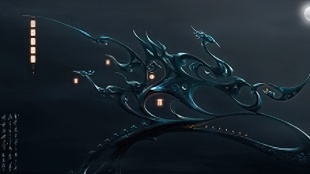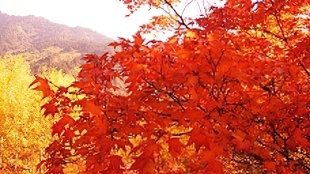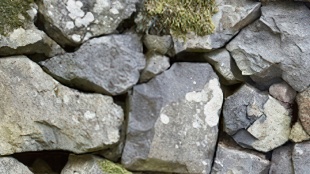您需要 登录 才可以下载或查看,没有账号?注册

x

Introduction
Hello, my name is Joris Brouwers and I’m a self-taught 3d artist from the Netherlands. I enjoy doing props and environment work with a focus on hard-surface modeling.
介绍
你好,我的名字是Joris Brouwers,我是一名来自荷兰的自学成才的3D艺术家。我喜欢做道具和环境工作,重点是硬表面建模。

Goals
As I’ve heard many good things about Blender I wanted to learn it myself, it’s the main reason for doing this project.
Additionally, I wanted to improve my ability to plan, so I budgeted time for each part of the process and started tracking time using an app called Harvest. Sticking to a budget also helped me in keeping the big picture in mind without getting stuck on details.
目标
由于我听说过很多关于Blender的好东西,我想自己学习它,这是做这个项目的主要原因。
此外,我想提高我的计划能力,所以我为流程的每个部分预算了时间,并开始使用一个名为Harvest的应用程序跟踪时间。坚持预算也帮助我牢记大局,而不会陷入细节困境。
The final model is intended to be animated and implemented in Unreal Engine 5 as a first-person weapon.
最终模型旨在进行动画处理,并在虚幻引擎5中作为第一人称武器实现。
Software
For modelling, I used Blender, ZBrush, Maya (UVs) and Marvelous Designer. Texturing was done using Substance 3D Painter. For the final renders, I used Marmoset Toolbag 4 and Photoshop for post-processing.
软件
对于建模,我使用了Blender,ZBrush,Maya(UV)和Marvelous Designer。纹理是使用Substance 3D Painter完成的。对于最终的渲染,我使用了Marmoset Toolbag 4和Photoshop进行后期处理。
Concept & References
The concept created by immediately caught my attention. It leaves a lot open for interpretation while providing enough detail to hint at all the different material types and their history. On top of that it’s a fun design that I felt provided the right amount of challenge for my current skill level.
To complement the concept art I’ve gathered a bunch of reference images as well.
概念与参考
https://www.artstation.com/artwork/686mNn创造的概念立即引起了我的注意。它留下了很多解释的余地,同时提供了足够的细节来暗示所有不同的材料类型及其历史。最重要的是,这是一个有趣的设计,我觉得为我目前的技能水平提供了适量的挑战。
为了补充概念艺术,我还收集了一堆参考图像。
Blockout
As usual, I started with a simple blockout to get an idea of all the different parts and their proportions.
封锁
像往常一样,我从一个简单的块开始,以了解所有不同的部分及其比例。
Because the concept doesn’t always show how wide something is I like to start with a cylinder since the height and width are the same. In this case, I started with the lightbulb which served as a good point of reference while blocking out the rest.
This model uses a lot of cylinders, pretty much the entire front half is round in some way. To save time later on I tried to use the right amount of edges for my cylinders as the blockout will eventually serve as a base for the low poly.
因为这个概念并不总是显示某物有多宽,我喜欢从圆柱体开始,因为高度和宽度是相同的。在这种情况下,我从灯泡开始,它作为一个很好的参考点,同时阻挡了其余部分。
这个模型使用了很多气缸,几乎整个前半部分在某种程度上是圆形的。为了节省时间,我试图为我的圆柱体使用适量的边缘,因为块最终将作为低多边形的基础。
High Poly
To model the high poly I used a workflow I learned from Simon Fuchs’ Military Radio Tutorial. It works by first creating a fully detailed “medium poly”, which is essentially the high poly without smoothed edges. I smooth the edges later in ZBrush.
高聚
为了模拟高多边形,我使用了从Simon Fuchs的军事无线电教程中学到的工作流程。它的工作原理是首先创建一个完全详细的“中等多边形”,这基本上是没有平滑边缘的高多边形。我稍后在ZBrush中平滑边缘。
This is roughly how it works:
这大致是它的工作原理:
I like this workflow because I don’t have to worry about topology as long as the shading looks good.
This workflow is especially suited for hard-surface work, topology becomes a lot more important when modeling organic stuff.
There are some downsides, however, like Dynamesh not being able to handle small or thin objects very well. I modeled these in Blender using subdivision modeling.
After going through each part I did a sculpting pass to add details like edge damages, welding seams and the wrinkles on the wire insulation.
我喜欢这个工作流程,因为只要着色看起来不错,我就不必担心拓扑结构。
此工作流特别适用于硬表面工作,在对有机内容进行建模时,拓扑变得更加重要。
但是,也有一些缺点,例如Dynamesh无法很好地处理小或薄的物体。我使用细分建模在Blender中对这些进行了建模。
在完成每个部分之后,我做了一个雕刻通道,以添加边缘损坏,焊缝和电线绝缘层上的褶皱等细节。
For the grip tape I decided to use Marvelous Designer after finding a helpful tutorial on . The simulation took a bit of trial and error but I’m glad I stayed persistent. After importing the final result in Blender I used Solidify to give it some thickness.
对于抓地力胶带,在https://www.youtube.com/watch?v=2VYfclbtRoM上找到有用的教程后,我决定使用Marvelous Designer。模拟需要一些尝试和错误,但我很高兴我坚持不懈。在Blender中导入最终结果后,我使用Solidify给它一些厚度。
Final high poly:
最终高聚体:
Low Poly
Modeling the high poly this way allows for quick low poly creation as well because the medium poly is perfectly suitable as a starting point. In most cases, all I had to do was remove the subdivision modifier and optimize the topology. No need to remove tons of support loops 🙂
低聚
以这种方式对高多边形进行建模也允许快速创建低多边形,因为中聚体非常适合作为起点。在大多数情况下,我所要做的就是删除细分修饰符并优化拓扑。无需删除大量支持循环 🙂
I also made sure to pay close attention to the silhouette, especially from the first-person view. I wanted the round surfaces to have enough edges to not look jagged or cause baking problems. It was challenging to stay consistent doing this; smaller pieces needed to have fewer edges than larger ones so that the overall resolution stays the same while also keeping other factors in mind like how important/visible a part is or the perspective it will be seen from. This model’s been great practice in this department!
For example, here I prioritized the first person view over the side view:
我还确保密切关注剪影,特别是从第一人称视角。我希望圆形表面有足够的边缘,以免看起来锯齿状或导致烘焙问题。保持一致是具有挑战性的。较小的部件需要比较大的部分具有更少的边缘,以便整体分辨率保持不变,同时还要牢记其他因素,例如零件的重要性/可见程度或从中看到的透视。这个模型在这个部门是很好的实践!
例如,在这里,我将第一人称视图优先于侧视图:
I went a bit higher in polycount than I normally would in a production environment as this is a portfolio piece, but I still wanted to optimize it as much as I could.
我在多边形计数方面比在生产环境中通常要高一些,因为这是一个投资组合部分,但我仍然想尽可能多地优化它。
Final low poly:
最终低聚体:
UVs & Baking
I like to prepare the UVs while working on the low poly so that most of the work is already done when I get to the unwrapping stage.
UV 和烘焙
我喜欢在处理低多边形时准备UV,以便在进入展开阶段时大部分工作已经完成。
By preparing I mean setting my hard edges correctly, making UV cuts based on those and hitting the unwrap button. I don’t look at the result, I’ll go over each part later anyway. You can automatically select sharp edges in Blender which helps to speed things up.
通过准备,我的意思是正确设置我的硬边缘,根据这些边缘进行UV切割并点击开包按钮。我不看结果,无论如何,我稍后会介绍每个部分。您可以在Blender中自动选择锋利的边缘,这有助于加快速度。
When ready I move to Maya for its Unfold and Straighten tools which work like magic to me. I really wish to have something similar in Blender, I even tried Textools and ZenUV but I haven’t found it yet.
准备就绪后,我搬到了Maya,因为它的展开和拉直工具对我来说就像魔术一样工作。我真的希望在Blender中有类似的东西,我甚至尝试过Textools和ZenUV,但我还没有找到它。
In Maya, all I do is go over each piece and double-check with a checkered material applied, making sure islands are nicely straightened and there is minimal stretching.
在Maya,我所要做的就是检查每件作品,并仔细检查应用方格材料,确保岛屿很好地拉直并且拉伸最小。
When I finish I bring everything back to Blender where I pack the UVs using UVPackmaster 3, which is now my favorite packer!
当我完成时,我把所有东西都带回Blender,在那里我使用UVPackmaster 3打包UV,现在是我最喜欢的包装机!
Before packing, I set the texel density so that all UV islands have the same resolution. I then increased the resolution of the islands that are close to the first-person camera and decreased the resolution of those that are mostly obscured or rarely seen (e.g. the bottom of the stock).
在包装之前,我设置了纹理密度,以便所有UV岛都具有相同的分辨率。然后,我提高了靠近第一人称摄像机的岛屿的分辨率,并降低了那些大多被遮挡或很少看到的岛屿(例如枪托底部)的分辨率。
I also overlapped identical islands to save UV space and moved them to adjacent tiles to prevent baking issues. UVPackmaster has some useful tools to help with this!
我还重叠了相同的岛屿以节省紫外线空间,并将它们移动到相邻的瓷砖上以防止烘焙问题。UVPackmaster有一些有用的工具可以帮助解决这个问题!
Finally, I divided all of the parts into two UV sets while maintaining relative texel density, which took some trial and error. Now I can apply two 4K materials for maximum quality.
For baking, I used Marmoset Toolbag 4. Luckily I faced only minor issues which were easily solved by using the Paint Skew tool or correcting the size of the cage.
最后,我将所有部分分为两组UV,同时保持相对纹理密度,这需要一些尝试和错误。现在,我可以应用两种 4K 材质以获得最高质量。
对于烘焙,我使用了狨猴工具包4。幸运的是,我只遇到了一些小问题,这些问题可以通过使用“油漆倾斜”工具或校正笼子的大小轻松解决。
I made sure to disable ambient occlusion for the glass parts and also the battery since it’ll be removed during the reload animation.
After baking I proceeded to set everything up in Painter. Usually, I use Studio Tomoco as my environment map but I found an amazing alternative on called Brown Photostudio 02. It has neutral colors and doesn’t contrast as much, which I like. I also changed the camera FOV to 30.
我确保禁用玻璃部件和电池的环境光遮蔽,因为它将在重新加载动画期间被移除。
烘焙后,我继续在Painter中设置所有内容。通常,我使用Studio Tomoco作为我的环境地图,但我在https://polyhaven.com/a/brown_photostudio_02上发现了一个惊人的替代方案,称为Brown Photostudio 02。 它具有中性色,并且没有那么多的对比度,我喜欢。我还将相机FOV更改为30。
Finally, it’s all set up and good to go. Now is when the real fun begins!
最后,一切都设置好了,可以开始了。现在是真正的乐趣开始的时候!
Texturing
Usually, I start by creating folders for all of the materials and get the masking done before anything else. I wanted everything to look rough, old and weathered to stick to the theme of the weapon being put together by a mad scientist.
纹理
通常,我从为所有材料创建文件夹开始,并在其他任何事情之前完成遮罩。我希望一切看起来粗糙,陈旧和风化,以坚持一个疯狂的科学家组装武器的主题。
Personally, I like to work on one material until it’s fairly detailed and then move on to the next. Every once in a while I look at the entire model and ask myself what stands out and where more work is needed. While doing this I consider each individual channel, so maybe there isn’t enough variation in the roughness map or colors are contrasting too much in the base color map.
I think it’s a lot about finding a balance between variation and uniformity. Your materials shouldn’t be too flat, there needs to be variation. At the same time, you don’t want anything to stand out too much either. This applies to individual materials, an entire asset and even complete environments.
就个人而言,我喜欢处理一种材料,直到它相当详细,然后继续下一种材料。每隔一段时间,我就会查看整个模型,并问自己哪些突出,哪些地方需要做更多的工作。在这样做时,我会考虑每个单独的通道,因此可能粗糙度贴图中没有足够的变化,或者颜色在基色贴图中对比太大。
我认为这很大程度上是为了在变化和均匀性之间找到平衡。你的材料不应该太平坦,需要有变化。同时,你也不想让任何东西太突出。这适用于单个材料,整个资产甚至完整的环境。
Below are some WIP renders:
以下是一些 WIP 渲染:
The way I approach a material is by first looking for a smart material that comes close to what I need, then disabling all of the layers and enabling them one by one starting from the bottom. I go through each layer and tweak values to fit my needs. I remove layers and add new ones.
Basically, I start with a default material and make it my own while closely examining my reference images.
我处理材质的方式是首先寻找一种接近我需要的智能材质,然后禁用所有层并从底部开始逐个启用它们。我遍历每一层并调整值以满足我的需求。我删除图层并添加新图层。
基本上,我从默认材料开始,并在仔细检查我的参考图像时将其作为我自己的材料。
A neat way to add variation is by duplicating the layer that defines the main color and giving it a slightly different color. Add a mask and assign it to different parts. This way you get color variation without having to duplicate the entire material. Changes made to other layers like dirt etc. will affect all versions as well.
添加变化的一种巧妙方法是复制定义主色的图层,并为其提供略微不同的颜色。添加蒙版并将其指定给不同的零件。通过这种方式,您可以获得颜色变化,而不必复制整个材料。对其他层(如污垢等)所做的更改也会影响所有版本。
Here are some breakdowns of a few materials:
以下是一些材料的一些细分:
A lot of the time it’s an accumulation of subtle details that make up the material.
For the barrel, I wanted to create the effect of steel that has repeatedly become hot and then cooled down again. I found a great plugin called that does exactly that, works like a charm! I used it to tint the fitting of the lightbulb as well to give it this cool metallic look, it’s a lot of fun to play around and experiment with the effect.
很多时候,它是构成材料的微妙细节的积累。
对于枪管,我想创造钢的效果,这种钢反复变热,然后再次冷却。我发现了一个名为https://www.artstation.com/marketplace/p/8gey/dynamic-hot-me ... gn=homepage&utm_term=marketplace的很棒的插件,它正是这样做的,就像一个魅力!我也用它来为灯泡的贴合着色,以赋予它这种酷炫的金属外观,玩转和实验效果很有趣。
Polishing
The moment I felt satisfied with the materials I continued adding unique details to break the repetition and give the weapon more character. Think about leaks, stickers, paint, decals (rust, dirt, damages), labels, etc.
I put together this alpha map which I used as a stencil to stamp down the text details.
抛光
当我对材料感到满意时,我继续添加独特的细节,以打破重复,赋予武器更多的个性。考虑泄漏,贴纸,油漆,贴花(生锈,污垢,损坏),标签等。
我把这个阿尔法地图放在一起,我用它作为模板来标记文本细节。
During this stage, I continued to observe the first-person view to make sure everything still looked interesting and pleasing from that perspective.
在这个阶段,我继续观察第一人称视角,以确保从这个角度来看,一切看起来仍然有趣和愉快。
Rendering
For this final task, I used Marmoset Toolbag 4. To keep things non-destructive I created a separate folder for each render with a new camera and lights within. Now I can always come back and modify each render with the lighting setup still intact.
This was my scene setup:
渲染
对于最后一项任务,我使用了狨猴工具包4。为了使事情保持非破坏性,我为每个渲染创建了一个单独的文件夹,其中包含一个新的摄像机和灯光。现在,我可以随时回来修改每个渲染,同时光照设置仍然完好无损。
这是我的场景设置:
I used the same HDRI as I used in Painter. For each shot I first tried to find a good camera position and sky rotation and then continued to add child lights by dragging the mouse in the sky preview window. I really love this feature, it can sometimes give you cool unexpected results.
我使用的HDRI与我在Painter中使用的HDRI相同。对于每个镜头,我首先尝试找到一个好的相机位置和天空旋转,然后通过在天空预览窗口中拖动鼠标继续添加子灯。我真的很喜欢这个功能,它有时会给你带来很酷的意想不到的结果。
After rendering I used Photoshop for post-processing. I didn’t do anything fancy, only adjusted the vibrance, contrast and brightness a bit. It can make a big difference and really give your renders that final touch. Here’s a before and after comparison:
渲染后,我使用Photoshop进行后期处理。我没有做任何花哨的事情,只是稍微调整了一下活力,对比度和亮度。它可以产生很大的不同,并真正给你的渲染最后一点。以下是之前和之后的比较:
At this point, I added the lightning effect after someone on Polycount inspired me with the idea.
在这一点上,我在Polycount上有人启发了我这个想法之后添加了闪电效果。
It’s simple geometry created using splines. In Marmoset I toggled the visibility for the animation and played around with the bloom and flare settings to give it more “power”.
I’m planning to learn more about VFX in Unreal Engine 5 to create actual lightning, something I’m really looking forward to!
它是使用样条线创建的简单几何图形。在《狨猴》中,我切换了动画的可见性,并尝试了绽放和耀斑设置,以赋予它更多的“力量”。
我计划在虚幻引擎5中学习更多关于视觉特效的知识,以创建真正的闪电,这是我非常期待的!
Conclusion
That’s about it! One last tip I would like to give is to take breaks. Come back after a few days while working on something else maybe. You’ll return with fresh eyes and really see things from a new perspective. It can do wonders, especially after working on the same project for a long time.
I really hope you’ve found this article informative or helpful in some way. Thank you very much for reading, and many thanks to Games Artist for inviting me!
结论
仅此而已!我想给的最后一个提示是休息一下。几天后回来,同时做其他事情。你会带着全新的眼光回来,真正从新的角度看待事物。它可以创造奇迹,特别是在同一个项目上工作了很长时间之后。
我真的希望你觉得这篇文章在某种程度上是有益的或有帮助的。非常感谢您的阅读,并非常感谢游戏艺术家邀请我!
|







 评分
评分






